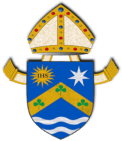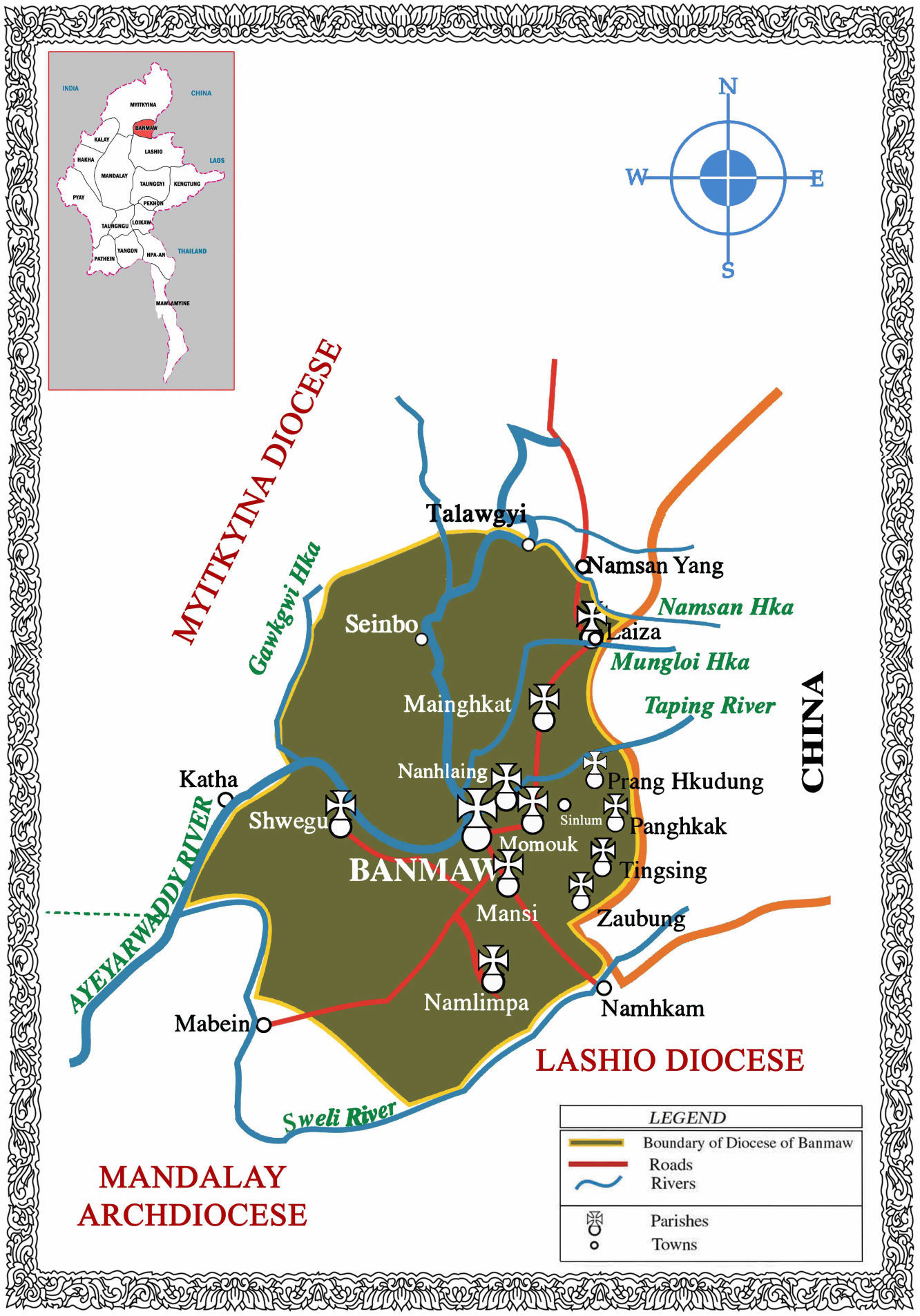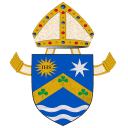Diocese & Our Bishop
Catholic Church
The Beginning
Creation of Banmaw Diocese
Banmaw Diocese was formerly part of Myitkyina Diocese.
On August 28, 2006, His Holiness, Pope Benedict XVI, seeing the need and for the good of local faithful, created a new Diocese of Banmaw suffragan to the Archdiocese of Mandalay.
On November 17, 2006, the Diocese was blessed and on the following day, Msgr. Raymond Sumlut Gam was ordained as the first Bishop of the Diocese of Banmaw and enthroned by His Grace, Archbishop Salvatore Pennacchio, the Apostolate Delegate to Myanmar.
Our Inspiration
“That They may have Life and have It Abundantly.”
(Jn. 10:10)
Our Vision
The Church that is a united and participatory people of God, working together with faith, hope and love to build God’s kingdom of peace and justice.
Our Mission
The Diocese of Banmaw seeks to empower as many people as possible in becoming fully developing followers of Christ.

Location:
The Diocese is situated in the Southeast part of Kachin State, which is in the Northern region of Myanmar, bordered with China to the East, Myitkyina Diocese to the Northwest, Mandalay and Lashio Dioceses to the South.
Area & Population:
Approximate to 10,741 sq.klm with Civil Population of about 372,275.
Catholic Christian Population is about 34,151.
General Statistics:
Bishop: 1
Priests: 28
Parishes: 13
Catholic Families: 6142
Religious Congregation: 6
Religious: 71
Major Seminarians: 9
Catechists: 234
Brief History of
The Diocese of Banmaw
✤ Early Missionary Work in Banmaw Region:
The early works in the Diocese of Banmaw traced back to the time of the great Legendary Missionary Bishop, Paul Ambrose Bigandet MEP (Missions Etrangers de Paris), the Foreign Mission Society of Paris. He was then the Vicar of Pegu, lower Burma, under the Colonial English Rule and the vicar of Ava which was the Kingdom of Burmese Kings in upper Burma.
The Bishop visited upper Burma in 1865, and came to see Banmaw, a town that was surrounded with wall and with a population of 2700 inhabitants. The Kachin lived in the hills around Banmaw and Bishop Paul Bigandet realized that these places were a good area for future missionary work. He then sent Fr. Louis Biet to Banmaw in 1872 and Fr. Liyet in 1873. Fr. Lecomte who taught English to the King’s family in Mandalay came to stay in Banmaw in 1874.
In 1877 Fr. Lecomte was able to build a clergy house-cum school in Banmaw with the help of the Myanmar King and Banmaw governor. The evangelization and mission work of the MEP gradually spread over Banmaw region amidst terribly difficult situation and deadly cerebral malaria and other sicknesses. In the course of thirty years (1972-1902), a total of 14 priests either died or returned with a weakened health and the work of the mission did not progress much.
However, with a new reinforcement of dauntless missionary priests, religious (Franciscan Missionaries of Mary Sisters in 1923) and Catechists from Taungoo and their undaunted missionary zeal, a community of faith was taking shape among the Kachin and Shan people in Banmaw region.
In Banmaw area, from 1872-1939, 31 French priests worked tirelessly in building the Kingdom of God. The well known among the priests were Fr. Charle Giholdes and Fr. Calude Roche. The latter was an outstanding missionary among Shans who came to station at Nanhlaing and built St. Michael Church there between 1928-1930, the first brick-nogging church ever built in this area.
✤ Arrival of Columban Missionaries:
The arrival of the first Columban missionary priests from Ireland gave great joy to the veteran missionaries. Divine providence was there once again to spearhead the entire work of evangelization with new vigour and fresh hopes. The first Columban missionaries set foot in Banmaw at the end of October 1936 to take over the mission from the MEP. Up to that time, the Banmaw Mission was under the pastoral care of the Mandalay diocese and the faithful were about 3000.
In 1939, the Holy See formally erected the districts of Banmaw, Myitkyina and Katha into the Prefecture Apostolic of Banmaw, and on the 11th of February of the same year, the French Missionaries officially handed over the mission to the Columban Missionaries at the village of Manmawkawng in Gauri Krung. Rev. Fr. Patrick Usher was named the first Prefect Apostolic. The Second World War disrupted the growing mission activities, and priests and nuns had to take refuge in Mandalay leprosy Colony. When they came back in 1945, the war left nothing for them. They had to start everything from the beginning.
The courageous Msgr. Patrick Usher died in 1958; consoled by the splendid recovery of the mission after the devastating war years, a good hope for the future of the church in Banmaw – Myitkyina area. The Vicar Delegate and Pro-prefect Rev. Fr. John Howe succeeded Msgr. Usher and a magnificent Church was built in Banmaw. Archbishop J.R. Knox who was then the Apostolic Delegate for Myanmar blessed the church in 1960.
In 1961, the Prefecture Apostolic was erected into diocese of Myitkyina and in the same year, Msgr. John Howe was consecrated Bishop of Myitkyina by His Grace Archbishop U Win of Mandalay. On the 27th March 1965, Msgr. John Howe and the Diocese had one of their greatest joys in ordaining the first Kachin Priest in the person of Paul Zinghtung Grawng.
As well prepared ahead on 3rd April 1976, Bishop Howe, with the mandate and blessing of His Holiness Pope Paul VI, ordained Fr. Paul Grawng as his Auxiliary Bishop. The following year the Diocese was handed over to the indigenous clergy and the Columbans finally left in 1979.
✤ Location and General Situation:
Banmaw Diocese is situated in the Southeast part of the Kachin State bordered with China to the East, Myitkyina Diocese to the Northwest, Mandalay Archdiocese and Lashio Diocese to the South.
Banmaw Diocese includes Banmaw, Momauk, Shwegu and Mansi administrative townships. It is approximately 10,741 Sq.klm with civil population of about 372,275 intercultural living with diverse ethnic people such as Burmese, Kachin, Karen, Shan, Chinese, Indian, and other tribes with their own dialects; and a Catholic population of 34,151 living scattered on the hill and the rest living on lower lands. There are 13 parishes with 1 Bishop, 28 priests, 71 religious, 3 Columban Lay Missionaries, 234 catechists, 9 major seminarians and about 18 minor seminarians in Banmaw diocese.
The greater part of the diocese is mountainous area with communication difficulties. The Ayeyarwaddy, the main river of the country, flows through the Western part of the region, North to South, providing water resources and means of transport and irrigation. Land roads and very occasional plane services facilitate travel in parts of the diocese, but some parts of the hill sections have to be covered on foot. Thirty percent of the land roads are paved with tar and forty percent with stone gravel and the rest are clay roads. All the parish centers can be reached by car but some of them are accessible only by a good condition 4-wheel drive car during the dry season.

